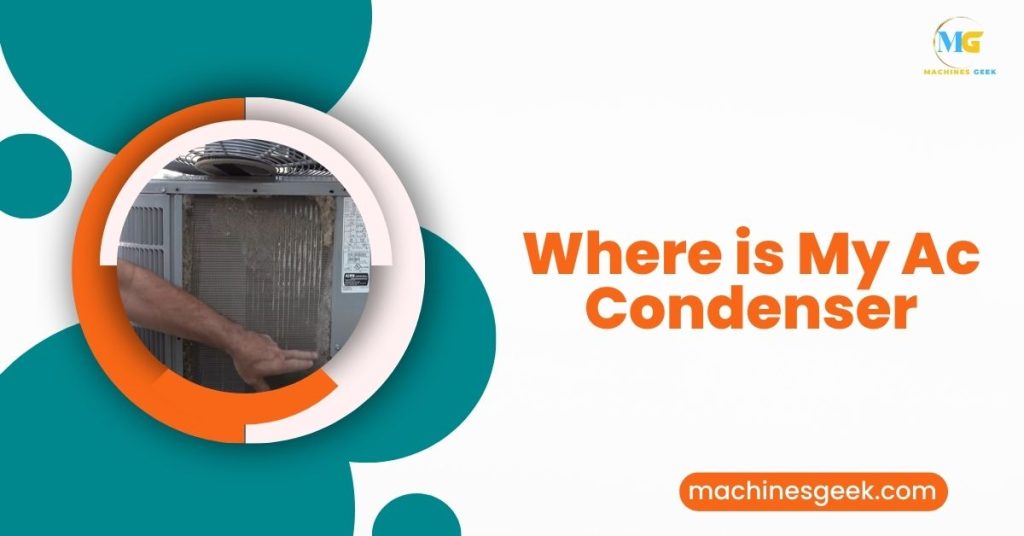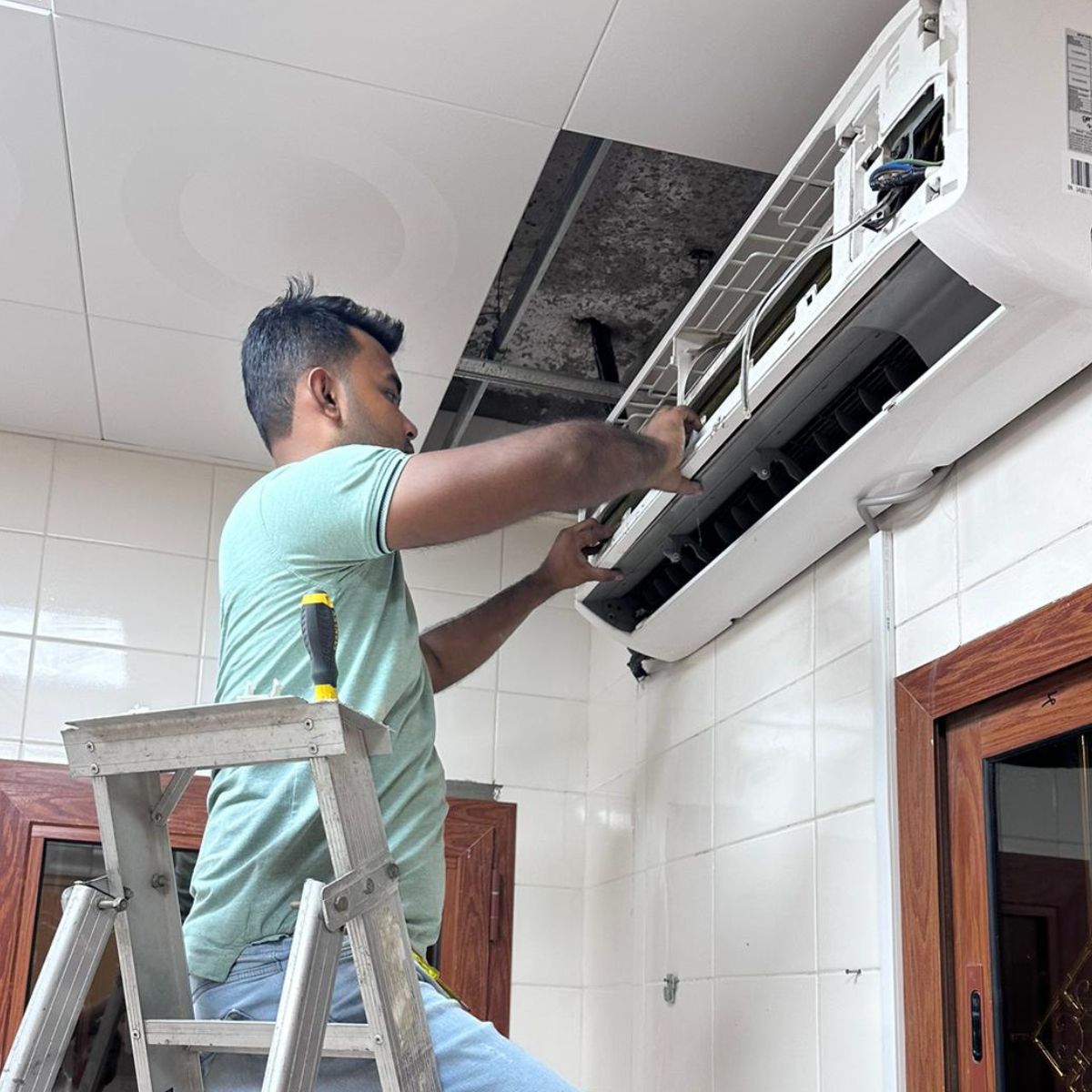Where is My Ac Condenser? Your AC condenser is located outside your home or building, typically positioned near the air handling unit. It serves as a vital component in the cooling process of your air conditioning system by removing heat from the refrigerant.
Perfectly situated outdoors, the AC condenser benefits from adequate airflow and ample space for efficient operation. With its location, the condenser can safely release heat into the surrounding environment. You must ensure that the area around the condenser remains clear of debris and obstructions to guarantee optimal performance and longevity of your AC system.
Components Of Your Ac System
A crucial component of your AC system is the AC condenser. Located outside of your home, the condenser plays a vital role in the cooling process. It works by releasing heat absorbed from inside your home to the outside environment.
The AC condenser consists of several key parts, including the refrigerant, compressor, condenser coils, and fan. The refrigerant, a chemical compound, circulates through the system, changing from a gas to a liquid and back again to absorb and release heat.
The compressor is responsible for pressurizing the refrigerant, allowing it to flow through the system. The condenser coils then remove heat from the refrigerant, converting it back into a high-pressure gas. Finally, the fan helps to dissipate the heat into the outdoor air.
Regular maintenance of your AC condenser is essential to ensure its proper functioning. Keep the area around the condenser clear of debris and vegetation, as this can inhibit airflow. Additionally, scheduling annual professional maintenance will help identify any issues before they become major problems.
Outdoor Placement Of The Ac Condenser
An important aspect of AC installation is determining the most ideal outdoor placement for the AC condenser. The location of the condenser plays a crucial role in the efficiency and effectiveness of your cooling system. Finding the right spot is vital to optimize its performance and to avoid any potential issues.
When selecting the perfect location for your AC condenser, there are a few factors to consider. Firstly, ensure that the condenser is placed in a well-ventilated area where it can easily expel heat. This will help prevent the system from overheating and improve its overall efficiency. Secondly, it is important to keep the condenser away from obstructions such as shrubs, fences, or walls that could block the airflow. Allowing sufficient clearance around the unit ensures that it can draw in adequate air for cooling purposes.
Additionally, consider factors such as noise and aesthetics. If possible, choose a location away from commonly used areas or bedrooms to minimize the noise generated by the condenser. Moreover, placing the unit in a visually appealing spot, such as behind bushes or trees, can help blend it into the surroundings and enhance the overall appearance of your outdoor space. Remember to consult with a professional HVAC technician to determine the most suitable location based on your specific requirements and the layout of your property.
Common Places For The Ac Condenser
AC condensers are typically installed in common areas outside the house. One of the common places for the AC condenser is the backyard or garden area. It provides easy access and ample space for the condenser unit to function efficiently.
Another common location for the AC condenser is the rooftop. Placing the condenser on the rooftop not only saves valuable ground space but also allows for better airflow and noise reduction. The side of the house is also a popular choice for installing the AC condenser. It ensures easy access for maintenance and repairs while also keeping the condenser unit hidden from view. Proper placement of the AC condenser is crucial for optimal performance and longevity.
Clearance Requirements
Proper clearance requirements for your AC condenser are essential to ensure optimal performance and longevity. When it comes to the distance from walls and fences, it is important to maintain adequate space for proper airflow. The condenser should be positioned at least 12 inches away from any walls or fences to allow for hassle-free maintenance and airflow.
This clearance requirement is crucial to prevent obstructions that can hinder the cooling process and potentially damage the system. Additionally, proper airflow around the condenser unit is necessary for efficient heat transfer, reducing strain on the system and improving overall performance. By following these clearance guidelines, you can ensure that your AC condenser operates at its best, providing you with cool and comfortable indoor air.
Proximity To Other Objects
Avoiding obstructions is crucial when it comes to the placement of your AC condenser. The condenser needs adequate space around it to function properly. Ensure that there is ample clearance to avoid potential issues.
It is important to keep your AC condenser free from debris such as leaves, dust, and other obstructions. These obstructions can hinder the airflow and reduce the efficiency of the condenser, leading to increased energy consumption and potential damage to the unit. Regularly inspect and clean the condenser to prevent any blockages.
| Problems caused by obstructions | Preventive measures |
|---|---|
| Reduced airflow | Clearance of at least 2-3 feet around the condenser |
| Increased energy consumption | Regular cleaning and maintenance |
| Potential damage to the unit | Keep the surrounding area clean and clear of debris |
Regular Cleaning And Inspection
Regular cleaning and inspection of your AC condenser is essential to ensure optimal performance and longevity. One of the key maintenance tasks is removing dirt and debris that accumulates on the condenser fins and coils.
Using a soft brush or a vacuum cleaner, gently clean the exterior of the condenser unit, removing any leaves, grass, or other debris that may obstruct airflow. Inspect the fins for any signs of damage or bending, as this can affect the efficiency of the unit. Additionally, check for any visible damage to the condenser coils or refrigerant lines, such as leaks or corrosion. It is important to address any issues promptly to prevent further damage and costly repairs.
Protecting The Ac Condenser From External Elements
The AC condenser is typically located outside the house, usually near the compressor. It is important to protect the AC condenser from external elements such as debris, plants, and weather conditions to ensure optimal performance and longevity of the unit.
Installing A Protective Cover
Protecting your AC condenser from external elements is crucial to ensure its longevity and efficient performance. Installing a protective cover can safeguard your condenser from harsh weather conditions, debris, and other potential damages.
A protective cover acts as a barrier, preventing leaves, branches, and dirt from entering the condenser unit. It also prevents rusting caused by rainwater or snow. When purchasing a cover, make sure it fits securely over the unit and is made of durable material to withstand outdoor conditions.
Providing shade to your AC condenser is another effective way to protect it from extreme heat. Positioning the condenser unit in a shaded area or building a shade structure around it helps reduce exposure to direct sunlight. This not only increases the condenser’s efficiency but also extends its lifespan.
Maintaining a clean and protected condenser ensures optimal functioning and reduces the risk of expensive repairs or replacements. Taking these preventive measures will help you maximize the performance of your AC condenser for years to come.
Frequently Asked Questions
Where Is My Ac Condenser Located?
Your AC condenser is typically located outside the house, near the foundation or on the rooftop. It works alongside the compressor to cool down the refrigerant.
How Does The Ac Condenser Work?
The AC condenser receives the hot refrigerant vapor from the compressor and cools it down by running it through a set of fins and a heat-exchanging coil. It then transforms the vapor into a liquid, ready to be circulated back into the house.
Why Is It Important To Maintain My Ac Condenser?
Regular AC condenser maintenance is crucial to ensure optimal cooling performance and energy efficiency. Cleaning the coils, checking for refrigerant leaks, and removing debris helps extend the lifespan of your unit and prevents costly repairs.
Could a Dead Animal in My Outside AC Unit Affect the Location of My AC Condenser?
Discovering a dead animal in your AC unit can disrupt the functionality of your condenser. Handling a dead animal in AC unit is best left to professionals to avoid damage and health hazards. Call an HVAC technician immediately to safely remove and clean the unit to prevent any further issues.
How Does the Location of My AC Condenser Affect Its Performance in My RV?
The location of your AC condenser in your RV can directly impact the performance of your unit. If it is placed in a spot with poor air circulation or excessive heat, it may lead to an rv air conditioner cycling issue. Ensure it is positioned properly to prevent this problem.
Conclusion
Understanding the location of your AC condenser is crucial for proper maintenance and efficient cooling in your home or office. By familiarizing yourself with its typical placement, you can avoid unnecessary troubleshooting and ensure timely repairs. Regularly check for any obstructions or damage to the condenser to maintain optimal performance.
Remember, a well-maintained condenser equals a comfortable and cool space during hot summer days.








